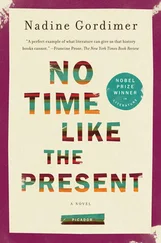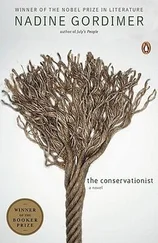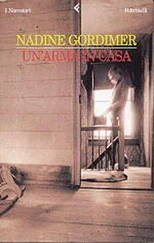Nadine Gordimer - Burger's Daughter
Здесь есть возможность читать онлайн «Nadine Gordimer - Burger's Daughter» весь текст электронной книги совершенно бесплатно (целиком полную версию без сокращений). В некоторых случаях можно слушать аудио, скачать через торрент в формате fb2 и присутствует краткое содержание. Год выпуска: 1980, Издательство: Penguin Books, Жанр: Современная проза, на английском языке. Описание произведения, (предисловие) а так же отзывы посетителей доступны на портале библиотеки ЛибКат.
- Название:Burger's Daughter
- Автор:
- Издательство:Penguin Books
- Жанр:
- Год:1980
- ISBN:нет данных
- Рейтинг книги:5 / 5. Голосов: 1
-
Избранное:Добавить в избранное
- Отзывы:
-
Ваша оценка:
- 100
- 1
- 2
- 3
- 4
- 5
Burger's Daughter: краткое содержание, описание и аннотация
Предлагаем к чтению аннотацию, описание, краткое содержание или предисловие (зависит от того, что написал сам автор книги «Burger's Daughter»). Если вы не нашли необходимую информацию о книге — напишите в комментариях, мы постараемся отыскать её.
Burger's Daughter — читать онлайн бесплатно полную книгу (весь текст) целиком
Ниже представлен текст книги, разбитый по страницам. Система сохранения места последней прочитанной страницы, позволяет с удобством читать онлайн бесплатно книгу «Burger's Daughter», без необходимости каждый раз заново искать на чём Вы остановились. Поставьте закладку, и сможете в любой момент перейти на страницу, на которой закончили чтение.
Интервал:
Закладка:
The other front-page story became one only when it was learned that a South African was involved. Before then it was a European affair, concerning the hijackings, kidnappings of industrialists and murders of embassy officials and politicians for which responsibility was claimed by, and sometimes imputed to international terrorist groups. A man known as Garcia, believed to be of Bolivian origin and belonging to the Armed Nucleus For Popular Autonomy (NAPAP), the Japanese Red Army, the Baader-Meinhof gang, or perhaps some new grouping including these and others, was thought to be the brain behind the most recent series of urban terrorist activities. He remained at large and had been sheltered by a number of women, each unaware of the others’ existence, with whom he had love affairs in London, Amsterdam and Paris. The one in Paris turned out to be a South African girl employed by the Citrus Board to promote the sale of oranges. The story dominated the Sunday papers; she was Marie Nel, daughter of a prominent Springbok Flats farmer, who with his wife also ran the dorp hotel. There were photographs of its façade, showing the bar and the name above it: C. J. S. Nel, Licensed to sell wine and spirituous liquors. There was a photograph of Marie Nel of the startled flashlight kind taken by itinerant photographers in nightclubs; the occasion appeared to be Christmas or New Year, and the venue must have been a South African city — a smiling Indian waiter in the background.
The story took on another week’s lease of life when one of the journalists, no doubt in the course of snooping about the dorp, learned that Mrs Velma Nel was the sister of Lionel Burger. To many readers this seemed some sort of explanation. The differences between the anarchic phenomenon of a Baader-Meinhof gang or something called the Japanese Red Army which had little to do with Japan, and the ideas of a Lionel Burger who wanted to hand over his country to the blacks, were blurred by the equal distance of such ideas from these readers’ comprehension. Marie Nel’s cousin, daughter of Lionel Burger and only surviving member of his immediate family, was working as a physiotherapist in a Johannesburg hospital. An old photograph reproduced from the newspaper’s files showed a young girl coming out of court in the course of her father’s trial.
Not even a postcard from the Musée de Cluny.
The unicorn among the beautiful medieval ladies, the tapestry flowers, shy rabbits; the mirror. O dieses ist das Tier das es nicht gibt . At the conjunction of the Boulevard Saint-Germain and the Boulevard Saint-Michel. An old abbey on the site of Gallo-Roman thermae, and she would walk into the court-yard described and up into the half-round hall where you can sit on the shallow well of steps and look at the six tapestries. On an azure island of a thousand flowers the Lady is holding a mirror in which the unicorn with his forelegs on the folded-back red velvet of her dress’s lining sees a tiny image of himself. But the oval of the mirror cuts off the image just at the level at which the horn rises from his head: a horn white as his coat, plumed tail, mane and curly beard, a tall horn delicately turned. Two tresses of her golden hair are bound with a fillet of pearls up round her oval face (like the gilt frame round the mirror) and twisted together on top of her head imitating the modelling of his horn, which at the same time is itself an artifice, êh, bone fashioned to imitate a spiral… A smiling lion holds an armorial pennon. Rabbits are there, a dog, a spotted genet. Foxes, cheetahs, lion cubs, a falcon pursuing a heron, partridges, a pet monkey tethered by a chain to a little roller — that was done to prevent it from climbing trees — these are to be made out round the representation of the other four senses:
The Lion and the Unicorn listening to music played in the garden by the Lady on her portable organ.
The Lady weaving sweet-smelling carnations into a chaplet while her monkey sniffs at a rose inquisitively pilfered from a basket.
The Lady taking sweets from a dish held by her maid; she may be going to feed them to her parakeet — the monkey is secretly tasting something good.
The Lady touches the Unicorn’s horn.
A sixth tapestry shows the Lady before a sumptuous pavilion or tent, amusing herself with a box of jewels. In medieval Bestiaries he is called a ‘monocheros’; he is there, paired with the Lion this time, holding aside with a hoof one of the flaps of the tent and gracefully rampant (the ridiculous position of a begging dog), supporting her standard. A legend is woven in gold round the canopy of the tent, A mon seul désir.
Here they are: to love you by letting you come to discover what I love.
There she sits, gazing, gazing.
An old and lovely world, gardens and gentle beauties among gentle beasts. Such harmony and sensual peace in the age of the thumbscrew and dungeon that there it comes with its ivory spiral horn
there she sits gazing
bedecked, coaxed, secured at last by a caress — O the pretty dear! the wonder! Nothing to startle, nothing left to fear, approaching—
There she sits, gazing, gazing. And if it’s time for the museum to close, she can come back tomorrow and another day, any day, days.
Sits gazing, this creature that has never been.
The children Rosa was teaching to walk who were born crippled were getting excellent rehabilitative care, better than her doctor half-brother could dream about providing in Tanzania. In the second half of 1976 those who were born deformed were joined by those who had been shot. The school riots filled the hospital; the police who answered stones with machine-guns and patrolled Soweto firing revolvers at any street-corner group of people encountered, who raided High Schools and picked off the targets of youngsters escaping in the stampede, also wounded anyone else who happened to be within the random of their fire. The hospital itself was threatened by a counter-surge of furious sorrow that roused the people of Soweto to burn and pillage everything the whites had ‘given’ in token for all, through three centuries, they had denied the blacks. The million or more (no one knows the exact figure) residents of Soweto have no municipality of their own; a white official who had done what he could, within the white-run welfare system for blacks, to help them endure their lives, was stoned and kicked to death. Other white officials had narrow escapes; several were rescued and hidden safely by blacks themselves, in their own houses. There was no way of identifying one’s white face as one that was different from any other, one that should be spared. The white doctors and other personnel among the hospital staff drove back and forth between the hospital and the white city of Johannesburg every day, privileged to pass through police roadblocks that isolated the Soweto area, and at the risk of being surrounded and dragged from their cars as they moved along the road where the armoured police vehicles the people called Hippos had gone before them, raising fists useless against steel plates and guns.
After the funerals of the first wave of children and youths killed by the police, at each successive burial black people were shot while gathered to pay homage to their dead or at the washing of hands at the house of the bereaved that is their custom. The police said it was impossible to distinguish between mourners and the mob; and they spoke more truly than they knew — mourning and anger were fused.
Although the white personnel at the hospital had knowledge of events and consequences in the black townships only touched upon by the reports in the newspapers gathered, among dangers and difficulties, by black journalists, no one of the white hospital staff could go into the places from which the patients came. Extracting bullets from the matrix of flesh, picking out slivers of shattered bone, sewing, succouring, dripping back into arteries the vital fluids that flowed away in the streets with the liquor from bottles smashed by children who despised their fathers’ consolations, these white people could not imagine what it was like to be living as their patients did. Rosa was visited one Sunday night in her flat by an acquaintance, Fats Mxenge. He apologized for turning up without warning, but it was not wise to use the telephone although (of course) he was one of the few people in Soweto to have one. He had a message; when it had been delivered he sat in her flat (a one-roomed ‘studio’ affair she had moved into when she returned from Europe) and accepted the brandy and hot tea she offered. He looked around him; someone brought aboard out of a tempest and seeing drawn curtains, lamplight, the turntable of the player circling where a record had just been lifted. He tossed off the brandy and then stirred the tea, knees close, stirred and stirred. Shook his head in summation — gave up. They exchanged the obvious. — Terrible, it’s terrible, man. I just want to get my kids out, that’s all. — She began to talk of some of the things she had seen at the hospital, not in her department: a little girl who had lost an eye; she was used to working with horrors (she used the word ‘deformities’) about which something could be done — nerves slowly brought back to feeling, muscles strengthened to flex again. — The left eye. Seven or eight years old. Gone for good. — She was not able to describe the black hole, the void she was seeing where the eye ought to be. — Last week the man who lives in the next house to us — you know our place? you’ve been there with Marisa — just there, the next house, he went out to buy something at the shop, candles, something his mother wanted. Never came back. She came over — she says, what must she do? Go to the police, my wife told her, ask them where he is — she thought he’s arrested. So the woman goes to the police and asks, where is my son, where can I look for him. D‘you know what they told that woman? ‘Don’t ask us here, go to the mortuary.’—
Читать дальшеИнтервал:
Закладка:
Похожие книги на «Burger's Daughter»
Представляем Вашему вниманию похожие книги на «Burger's Daughter» списком для выбора. Мы отобрали схожую по названию и смыслу литературу в надежде предоставить читателям больше вариантов отыскать новые, интересные, ещё непрочитанные произведения.
Обсуждение, отзывы о книге «Burger's Daughter» и просто собственные мнения читателей. Оставьте ваши комментарии, напишите, что Вы думаете о произведении, его смысле или главных героях. Укажите что конкретно понравилось, а что нет, и почему Вы так считаете.












